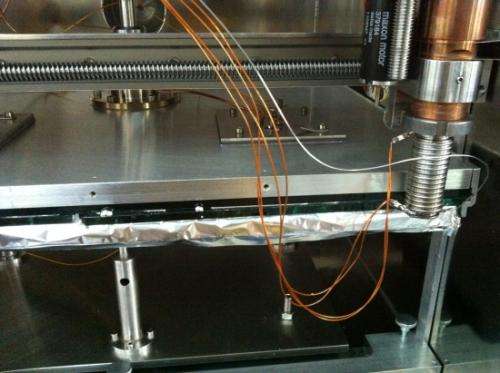"Intelligent" windows in our future

Windows are a high-tech venture. Empa researcher Matthias Koebel's "Winsmart" project has garnered the attention of EU experts, recently being recognized as the best in its class and receiving about €3.8 million to support development. These "intelligent" windows achieve a new level of air tightness: 30 years. The Winsmart project, which beat 21 competing proposals, is intended to develop technologies that improve the insulating ability of windows made of conventional glass and to add functional properties such as optically "switchable" coatings.
A thinner yet better insulating window
Conventional double glazed windows consist of two glass sheets mounted in an aluminium frame. This frame also encloses the 1.5 to 2 cm thick gap between the panes which is sealed with silicone and filled with a noble gas. The gas prevents the transmission of heat through the window. The Winsmart researchers have developed a new vacuum insulating system which measures only one third the thickness of conventional double glazed windows. The space between the panes is evacuated to a high vacuum thus giving it its superior insulation performance. The gap between the panes is only 0.2 to 2.7 mm wide and is maintained by a large number of tiny spacers placed between the glass sheets.
The kind of aluminium frame used today in conventional window production would, however, immediately buckle under atmospheric pressure and no longer be able to maintain its structural integrity. In addition the leak tightness of conventional construction techniques is inadequate for a vacuum glazing. For these reasons the surrounding frame has to be made more robust. In a patented process the two glass panes are placed in a vacuum chamber and a liquid tin alloy is injected all around the edges of the cavity to form the so-called edge seal. However because of the differences in surface tension between glass and liquid tin, the latter behaves like rainwater on a lotus leaf – water droplets are simply running off. The scientists overcame this problem by applying an electric voltage to the tin metal for short period of time, a necessary process step to ensure that the metal adheres properly to the glass and that, after solidifying, the seal strengthens and remains airtight for the next 30 years as required.

Shades and roller-blinds soon unnecessary?
The second focal area of Winsmart concentrates on the coating of the glass panes and involves research on switchable glasses. A process called vacuum sputtering is used to deposit thin layers of material a mere 100 to 200 nm thick on the glass panes. This is also done in a vacuum chamber, with the materials to be deposited being vaporized at high temperature, upon which they are allowed to condensate onto the glass surface. In this way, first an electrically conducting layer is created, on top of which a switchable layer made of, for example, tungsten oxide is laid down. This type of functional device layer is therefore always enclosed between two electrically conducting layers. At the press of a button, a battery or power supply lets current flows through the layered device and the tungsten oxide reacts to darken the glass. If the window of the future were able to measure the illuminance, that is the amount of light falling on it, it could autonomously darken or lighten itself as necessary, thus obviating the need for anyone to press buttons. In theory a number of different coatings could be laid down on top of each other to make the glass water repellent or scratch resistant in addition to the optical switching functionality. Koebel's team is developing alternative wet chemical processes to do this this, replacing the vacuum sputtering technique which is both energy and cost intensive.

Mass production in five to ten years
Cutting the glass to size, applying switchable layers, sealing the edges under high vacuum – all these steps should in future take place one after the other on a production line. So, in cooperation with the industrial partners, advanced production technologies are also being developed in the Winsmart project. One current challenge is developing the robots to be used to inject the liquid metal between the glass panes. Despite this hurdle Koebel is confident: "In 5 to 10 years the first Winsmart windows will be available on the market!"



















